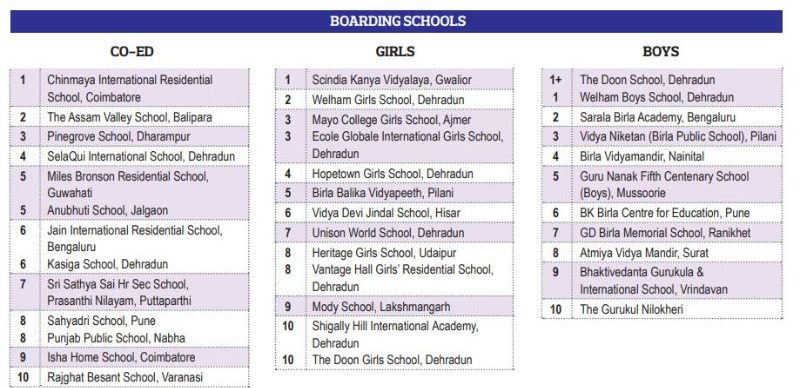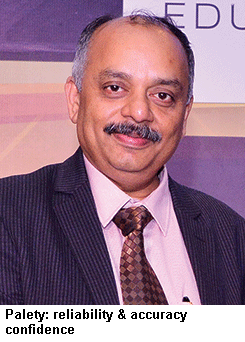In this issue, we present national, state, and parameter league tables of boarding schools (co-ed, boys and girls), international (co-ed day, day-cum-boarding, residential), vintage legacy, government, special needs, budget private and philanthropy schools, writes Dilip Thakore & Summiya Yasmeen

Since the EducationWorld India School Rankings (EWISR) were somewhat tentatively and experimentally launched in 2007, they have evolved into the world’s largest annual schools ranking survey which rates the country’s most admired primary-secondary schools on 14 parameters of education excellence.
Scores awarded by over 14,000 knowledgeable sample respondents under each parameter are totaled and schools are ranked in 22 discrete categories to facilitate peer institutional comparison. The underlying philosophy of the annual EWISR is that there’s much more to education than academic learning, and that children’s schooling should be a holistic, enjoyable education and personality development experience.
That’s why in a radical departure from global practice to rank schools under just one parameter — learning outcomes — the annual EWISR assesses the country’s best schools under 14 parameters including teacher welfare & development, leadership, academic reputation, co-curricular and sports education, individual attention to students, infrastructure among others.
The maximum possible score under each parameter is 100 except that the vitally important parameter of teacher competence is accorded double weight. Assessment of schools under multiple performance parameters compels institutional managements to ensure that students receive balanced, well-rounded education to develop their unique intelligences.
Evidently this core philosophy driving the annual EWISR now in its 15th year, has resonated with parents and educators’ communities countrywide. In 2007, a mere 250 schools countrywide were sufficiently well-known (institutions rated by less than 25 sample respondents are not ranked) in the survey league tables.
In EWISR 2022-23, over 4,000 schools included in national, state and city league tables are ranked. With schools and education leaders raising their public profiles and volunteering to be rated and ranked for the purpose of attracting best teachers and students, and parents across the country aspiring to choose the most suitable schools for their children, EWISR has transformed into the world’s largest and most detailed schools ranking survey. Moreover, with the number of schools in 22 sub-categories grouped under four main categories — day, boarding, international and vintage legacy — having risen exponentially, for the past three years, the annual EWISR is spread over two consecutive issues of EducationWorld.
In last month’s bumper 344- page issue, we presented Part I of EWISR 2022-23 rating and ranking day primary-secondary (co-ed day, day-cum-boarding, boys day and girls day) schools and vintage legacy schools under these categories.
IN THIS ISSUE, WE PRESENT Part II of EWISR 2022-23 featuring league tables ranking India’s best boarding (co-ed, boys and girls) and international schools affiliated with offshore examination boards (day, day-cum-boarding and residential). In addition, league tables rating and ranking top government (Central and state), Top 20 Special Needs Schools for differently-abled children, Top 15 philanthropic schools and Super 30 affordably priced budget private schools (the complete rankings to be featured in a forthcoming BPS dedicated issue) are included in this issue. “The sheer scale and depth of EWISR 2022-23 is unprecedented in India and worldwide. Over a period of four months, 122 field researchers conducted interviews in 28 cities across the country. They persuaded 14,221 SEC (socio-economic category) ‘A’ fees paying parents, teachers, principals, educationists and senior school students to rate the schools they are aware of on a ten-point scale under 14 parameters, viz, teacher welfare and development, teacher competence, academic reputation, co-curricular activities, internationalism, individual attention to students, curriculum and pedagogy (hybrid learning readiness), sports education, infrastructure, value for money, leadership/management quality, parental involvement, mental & emotional well-being services, special needs education, and community service. Reclusive, low-profile schools evaluated by less than 25 sample respondents were eliminated from the ranking process. The score awarded by every respondent under each parameter was totaled to rank schools in each sub-category,” explains Premchand Palety, promoter-CEO of the Delhi-based Centre for Forecasting & Research Pvt. Ltd (C fore, estb.2000) which has been conducting the annual EWISR for the past 15 years.
Moreover in response to public and institutional demand that vintage schools with decades of community service are a class apart, this year ‘vintage legacy schools’ are separately ranked in each sub-category. This innovation is a continuation of your editors’ efforts to make the annual EWISR survey more diverse and targeted.
Over the past 15 years, this annual survey has expanded to include government day, government boarding, special needs and budget private schools which admit children from low-income SEC (socio-economic category) B, C and D households. To rate and rank latter institutions, a separate sample database of 4,000 respondents comprising parents, students, teachers, principals and educationists was interviewed over two months.
This elaborate architecture of the annual EWISR distinguishes it from school rankings surveys abroad, especially in the UK which rate and rank schools inter se on a single parameter viz, academic learning outcomes. After EducationWorld pioneered its multi-dimensional EWISR 15 years ago, several imitative schools ranking surveys have been launched by some professedly education magazines which have flagrantly plagiarised this publication’s carefully conceptualised parameters of school excellence. However, all of them lack the robust field survey evaluation methodology that defines the annual EWISR.

“Apart from equipping parents with information to choose the most appropriate school for their children, the annual EWISR also fulfils the very important objective of enabling school promoters and managements to compare themselves with their peers under all parameters of school education excellence, and strive to attain whole institutional improvement year-by-year. The socially beneficial outcome is that the entire school education system improves with students better prepared for higher education and eventually their workplaces and vocations,” adds Palety, an alum of the highranked Punjab Engineering College, Chandigarh and Fore School of Management, Delhi, who began his career in ORG, India’s pioneer retail market research firm, and later went solo and promoted C fore in the millennium year.
Although the defining characteristic of the globally unique EWISR is its evaluation of schools across a broad range of parameters, criticism that the survey is based on perceptions rather than hard data is often articulated. Therefore, to add an element of objectivity to perceptual scores awarded by sample respondents under the vitally important, double weightage teacher competence parameter, since 2021, all EWISR schools have been invited to nominate six teachers to take a 30-minutes (20 questions) English, maths and science online test, administered by the Bengaluru-based Centre for Teacher Accreditation (CENTA, estb.2014). CENTA is India’s largest teachers’ online platform which provides testing, certification, training and career development programmes for K-12 teachers.
“During the past 12 months, we have experienced 1.5 million selfdriven ‘learning engagements’ with teachers on the MyCENTA platform. This is encouraging response indicating that our objective of teachers being rewarded for their competencies and therefore ready to learn continuously, is taking root. EWISR evaluates schools on a range of parameters including teacher competence, which is rightly given double weightage. Teachers of schools that did well in the 30-min CENTA test — a subset of our regular CENTA Teaching Quotient test — demonstrated acceptable levels of subject competence. Therefore, their score under this parameter has improved. We strongly advise all schools to avail this opportunity to assess their actual teacher competence and simultaneously improve their EWISR scores,” advises Ramya Venkataraman, a former McKinsey India consultant and promoter-CEO of CENTA.
Schools which deputed the prescribed cohort of teachers to write the online CENTA-EWISR test are accorded a 10-15 percent higher score under the all-important parameter of teacher competence. Last year when the CENTA test was introduced, only 15 percent of schools in the EWISR league tables nominated teachers to take this test. For the EWISR 2022-23 survey, 20 percent of schools deputed teachers to take the test and improved their scores under the teacher competence parameter.
Creating a separate broad category of vintage legacy schools apart, another innovation of EWISR 2022- 23 is that in instances where two or more schools are ranked #1, we have awarded a 1+ rank to institutions which have undertaken extraordinary initiatives during the past year.
In this (October) Part II issue, we present national, state, and parameter league tables of boarding schools (co-ed, boys and girls), international (co-ed day, day-cum-boarding, residential), government, special needs, budget private and philanthropy schools.
For the full list, please refer to: EW India School Rankings 2022-23 – Top & best schools in India


























